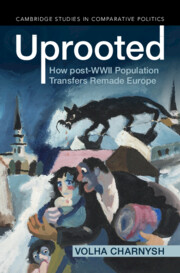Book contents
- Frontmatter
- Contents
- Figures
- Maps
- Tables
- Preface and Acknowledgments
- Abbreviations
- Part I Introduction
- 1 Understanding Forced Migration
- 2 Europe’s Zero Hour: Population Transfers in the Aftermath of WWII
- Part II Social Cohesion and Public Goods
- Part III State Building in the Wake of Displacement
- Part IV Long-Run Economic Consequences of Uprooting
- Appendix A Additional Maps, Figures, and Tables
- Appendix B Sources for Archival and Statistical Data
- References
- Index
- Cambridge Studies in Comparative Politics
1 - Understanding Forced Migration
from Part I - Introduction
Published online by Cambridge University Press: 07 November 2024
- Frontmatter
- Contents
- Figures
- Maps
- Tables
- Preface and Acknowledgments
- Abbreviations
- Part I Introduction
- 1 Understanding Forced Migration
- 2 Europe’s Zero Hour: Population Transfers in the Aftermath of WWII
- Part II Social Cohesion and Public Goods
- Part III State Building in the Wake of Displacement
- Part IV Long-Run Economic Consequences of Uprooting
- Appendix A Additional Maps, Figures, and Tables
- Appendix B Sources for Archival and Statistical Data
- References
- Index
- Cambridge Studies in Comparative Politics
Summary
This chapter introduces cases motivating the book and presents a three-step argument about the effects of forced migration on societal cooperation, state capacity, and economic development. It reviews evidence from post-WWII displacement in Poland and West Germany, discusses the applicability of the findings to other cases, and highlights the main contributions of the book.
Keywords
- Type
- Chapter
- Information
- UprootedHow post-WWII Population Transfers Remade Europe, pp. 3 - 30Publisher: Cambridge University PressPrint publication year: 2024

